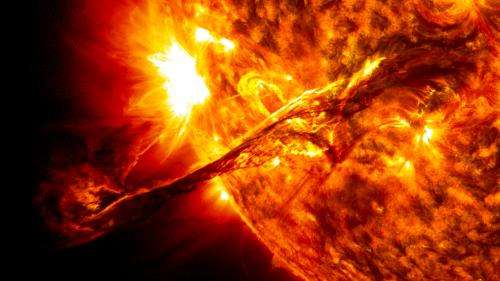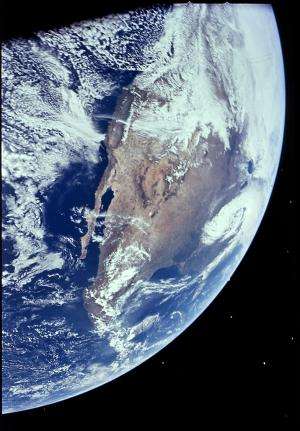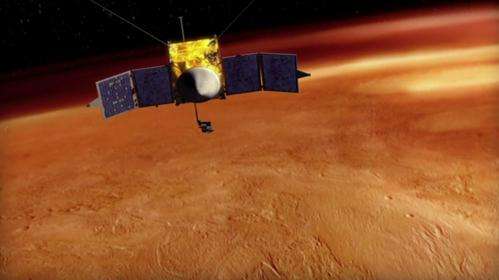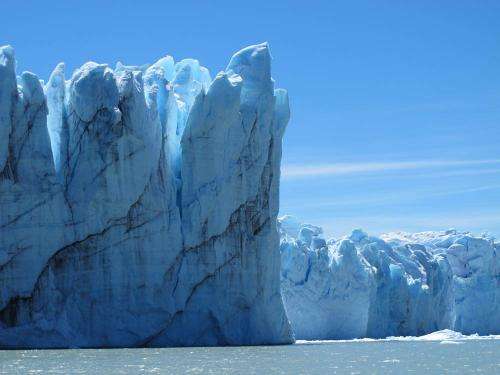The sun was underpowered when it was younger, emitting energy that is 20% to 25% lower than today. Credit: NASA/SDO
Earth's Sun was a weakling when it was younger. Around three or four billion years ago, the star's energy was about 20 percent to 25 percent lower than what's experienced today. If that was still true today, one would expect Earth would be an iceball, but the geologic record shows no evidence of a global ice age back then. What exactly kept the Earth warm during that time?
Bernard Marty is one of the researchers examining this so-called "young Sun paradox." As a geochemical professor at Lorraine University in France, he is interested in learning what gases were present in the atmosphere – and in what abundances – that could have sheltered the Earth against the cold.
Warmth on the Earth's surface comes from a combination of the Sun's rays striking the planet, the "greenhouse effect" in our atmosphere that naturally traps the heat close to Earth, and other sources such as volcanoes. Marty's group is trying to understand how the atmosphere changed over the eons. If there was an abundance of one kind of greenhouse gas that acted as an insulator against the cold, for instance, this could show up in the geologic record.
"We do have some choices for understanding the early atmosphere," Marty said, adding that so-called noble gasses, or elements with low chemical reactivity, could serve as barometers to understanding features such as how the Earth's magnetic field behaved early in the planet's history.
While Marty's research does not specifically address how these conditions affect life, these are questions that biologists are considering. By better understanding the environment under which life arose on Earth, we can then look to other planets – even planets outside the solar system – and identify which ones would be promising candidates to look for extraterrestrial life.
Tiny bubbles
One method of getting at the Earth's early atmosphere is to find samples of air that were trapped in very old rocks. Marty's team recently published two papers based on samples from a region of northern Australia that contains rocks formed billions of years ago. Air bubbles formed inside of the ancient quartz while the silica rock was being heated in the Earth's crust.
By analysing the air inside of these rocks, it's possible to learn things such as what isotopes or types of nitrogen were present a few billion years ago. There are two types of nitrogen in abundance in Earth's atmosphere that have different atomic weights – 14N and 15N – with 15N being slightly weightier of the two.
It's possible that the composition of greenhouse gases changed in Earth's atmosphere over billions of years. Credit: NASA
With no protection from a magnetic field, these two forms of nitrogen escape naturally from the atmosphere and into space. This occurs when the solar wind – particles sent out by the Sun – hits Earth's atmosphere and charges (ionizes) its particles. Without a magnetic field, this charging is more intense and the nitrogen escapes more rapidly.
Marty's group discovered that nitrogen isotopes trapped in rocks that are 3.5 billion years old are there in just about the same ratio as today. This means researchers "can propose Earth had a magnetic field against escape of lighter elements to space" early in its history, he said. Mars, by contrast, did not have a magnetic field and lost much of the lighter form of nitrogen over the years.
They also discovered that the partial pressure of nitrogen back then is about the same as it is today, which has implications for understanding how much carbon dioxide was in the early atmosphere. Nitrogen abundance in the atmosphere helps improve the insulating factor of carbon dioxide, which could have kept the Earth warm when the Sun was young.
The nitrogen wasn't quite enough to create this effect, however, so carbon dioxide may not be the solution. Still, the team's upper limit of partial pressure of carbon dioxide – 0.7 bars – is different from independent results based on carbon dioxide trapped in fossil soils. More research is needed to understand this, Marty said. His team's work was published in the journal Science in October.
Creating the continental crust
While tracking down carbon dioxide in the atmosphere, Marty's team is also examining the presence of the gas in ancient continental crust. As the crust formed, topography forced carbon dioxide in the atmosphere to come down as acid rain. As the carbon dioxide entered the crust, it then flowed into the ocean and precipitated as a sold carbon – carbonate.
"The crust acts as a sink for the carbon dioxide," Marty explained. The crust began to grow rapidly around three billion years ago, decreasing the partial pressure of carbon dioxide over time. Because there was less carbon dioxide in the atmosphere, the Earth got cooler and this caused the first known global ice age about 2.5 billion years ago.
Mars lost much of its nitrogen early in its history, presumably because it has a weak magnetic field. NASA's MAVEN spacecraft will study more about the planet's atmospheric composition when it arrives at Mars in September 2014. Credit: NASA/Goddard Space Flight Center
To see the carbon dioxide abundance in ancient times, Marty's team again turned to 3.5-billion-year old quartz and extracted an isotope of argon (argon 40) from the samples. This isotope was not around when the Earth was formed, and only came into being through radioactive activity due to naturally occurring potassium, an element common in the continental crust. One isotope of potassium indeed changes into argon-40 through time. The evolution of argon pressure, in turn, depends on the amount of potassium at the Earth's surface, and therefore of the development of the continental though geological eons.
Argon 40 showed up in abundance of just half the present value, the researchers discovered. Plugging this value into a model of the Earth's atmosphere, mantle and crust that the researchers created, they discovered the continental crust growing much quicker than previously believed.
"Most of the continental crust was created in a short period of time. Between 3.5 billion and 2.8 billion years ago, 90 percent of the continental crust was created," Marty said of the research, which was published in the journal Nature in June.
There are several more noble gases to consider, however. Marty is now examining xenon, which is a key tracer for learning how much ultraviolet light was produced by the Sun. Xenon in the atmosphere is "under-abundant by a factor of 20" when compared to other noble gasses, Marty said. "We don't know why it's different."
The Perito Moreno Glacier (Argentina). Scientists are trying to figure out under what circumstances global ice ages gripped the Earth in the last few billion years. Credit: Etienne Berthier, Université de Toulouse
Because xenon is the heaviest of the noble gases and has the most electrons or charged particles, it is very easy for ultraviolet light to push it out of the atmosphere. When the UV rays strike the electrons, this ionizes them and makes it easier for them to escape into space. So by looking at the amount of xenon in the atmosphere over time, researchers can also figure out how much UV radiation was coming from the Sun.
"We're analysing more samples with different ages and we are seeing the evolution," Marty said. Because xenon is found in different abundances in these samples, "We think that this implies that the xenon composition has been evolving through time and it was not fully in the atmosphere 3.5 billion years ago."
Provided by Astrobio.net



























